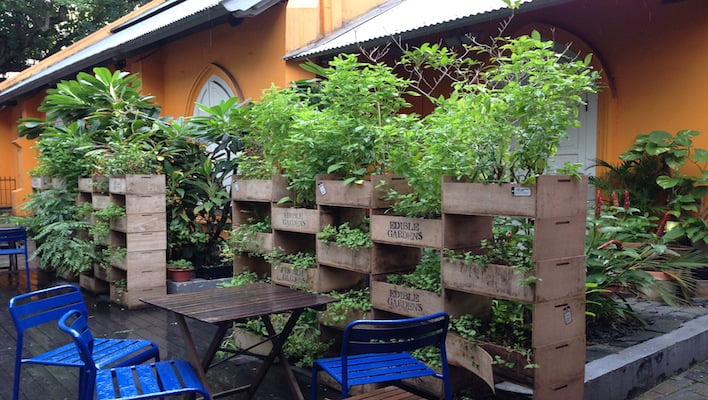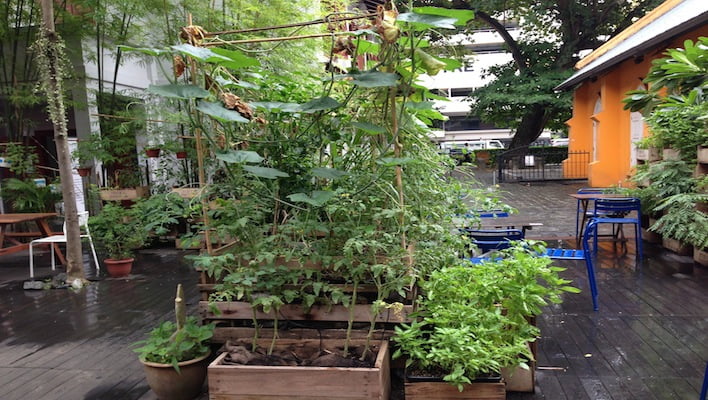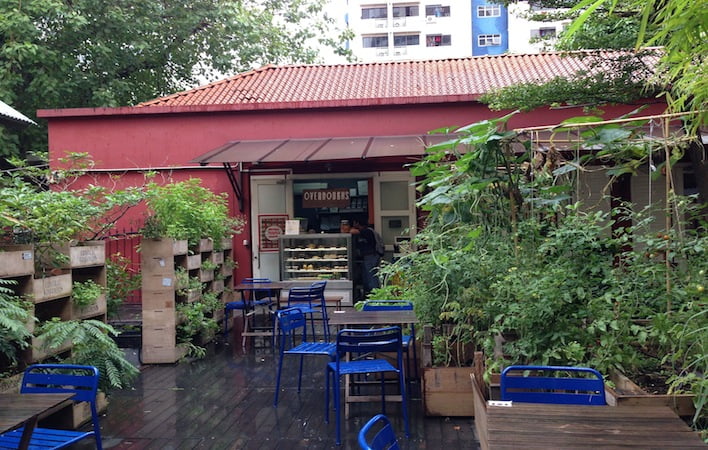Can green space and gardens be good for business? Many restaurants in Singapore are now experimenting with produce growing, and changing their ambience with greenery and gardens. It’s hard work but it brings results.

artichoke courtyard
From the moment you walk into artichoke’s courtyard, right in the heart of Singapore, it’s like walking into a little pocket of tranquility. The cobblestoned space is filled with lush and leafy greenery. The rustic setting with wooden tables and a space designed for big groups is ideal for eating food served for sharing. This is a welcoming and homely kind of place.

artichoke lane
Only moments away is the busy train station at Bugis, a shopping mecca, business centre and foodie hub. But here in the courtyard of Sculpture Square you could be forgiven for thinking you’re in the countryside. The chef and owner, Bjorn Shen, has a keen enthusiasm for all things green. That includes an interest in ‘urban farming’ which has developed out of a desire to support local growers but also to pay due respect to where food comes from. Many would laugh at the thought of a restaurateur trying to achieve such a goal on a small island with little in the way of farming land, but not Bjorn. He has, “tr[ied] to set a bit of an example for everyone else. Just to say it actually is possible, growing your own [food] and going green in Singapore actually can be done.”

artichoke chicken sausages
Singapore is a country with only 1.47% of arable land and in 2010 had the highest carbon footprint per capita in the Asia Pacific. These are pretty grim statistics if you’re trying to reduce your carbon footprint. Luckily Bjorn Shen found another Bjorn, Bjorn Low, an altruistic entrepreneur who chucked in the corporate life in 2012 to establish a social enterprise aptly named Edible Gardens. Bjorn Low can be credited with helping Singaporeans learn a little more about the farming process, and giving them the means to become more self-reliant on their food sources. Bjorn describes his role like this:
“Most Singaporeans buy their vegetables from supermarkets. I teach them how to grow their own.”

artichoke mezze
The Two Bjorns have much in common; passion, commitment and humour to name a few. Their urban farming collaboration that has produced the greenery at the centre of the Sculpture Square restaurant is unique not only for its visually appealing features, but because, like the name says, the garden is edible.
Commitment to sourcing locally is what led Bjorn Shen to establish the garden at artichoke. Given the small space though Bjorn could not possibly grow all his own vegetables for artichoke. Then of course there’s the other fresh produce like eggs, meat and fish that are needed to feed hungry diners. For that reason, Bjorn has spent many man hours scouring Singapore’s farms to find farmers willing to work with him and grow produce not necessarily native to Singapore or Asia in general. This commitment has led to between 30% and 60% of artichoke’s produce being sourced locally, a remarkable achievement given that in 2010 over 90% of food was imported into Singapore. Not many restaurants in Singapore could say that they’re, “completely self-sufficient when it comes to herbs such as basil and mint,” but artichoke certainly can.

artichoke’s babaganoush
Many restaurants in Singapore are following suit and featuring some kind of edible greenery in their space. Jamie’s Italian at Vivocity features an Edible Garden by Bjorn Low in their alfresco area. Primarily hardy herbs like rosemary and oregano feature here, more as an aesthetically pleasing addition than a practical food source, but at least the sentiment is there. Bjorn Low has also created a steady stream of similar concept gardens for other restaurants like Cajun Kings and Morsels and he recently completed a garden project at the top of Marina Bay Sands.

artichoke overdoughs
This kind of venture doesn’t come cheap though. Bjorn Shen estimates he’s spent more than SGD$5,000 on his project, but for all the cost and problems entailed, Bjorn says, “For me, this is worth doing”. You can imagine that if every restaurant in Singapore had a similar approach, the carbon footprint of this city-state could be hugely minimised. Not to mention that, as Bjorn Low of Edible Gardens says, that it’s definitely worth it for Singaporeans to establish more of a “connection to nature”, as well as “educating [their] kids”. Starting with gardens in public spaces is a great way of raising awareness of food sourcing as well as improving the supply chain.
This kind of cost has to be absorbed somewhere though and most restaurants aren’t willing to commit the time and money to this kind of project. Bjorn Shen has described the process as “slow and also quite tedious…at times,” but, “I think nothing that’s good is ever that easy.” Bjorn also believes his customers are generally, “value conscious but not price conscious.” In other words, if customers are receiving quality produce and cooking then this can be reflected, to some extent, in the prices. Let’s hope customers continue to appreciate Bjorn’s efforts and other restaurants follow suit.
Quotes are from Victoria Milner’s interview with Bjorn Shen and the Channel News Asia feature on It Figures Outliers
[You can read more about Singapore dining and Victoria’s excellent restaurant reviews at Singapore Foodie]
